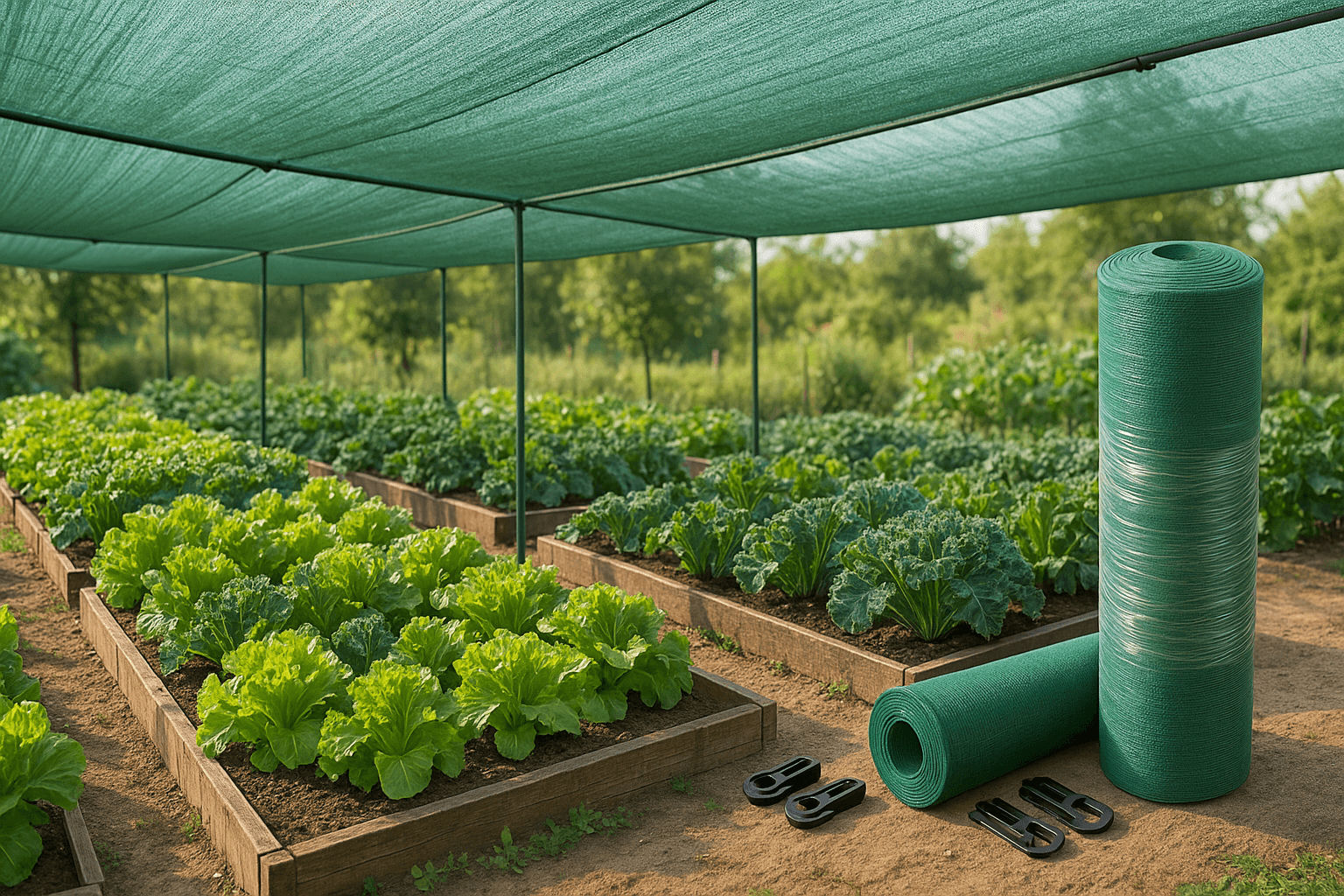Online vs Local: Where Can I Buy Shade Cloth for My Garden
Scorching summers are pushing both home gardeners and commercial growers to look for reliable ways to cool their crops. Shade cloth—woven or knitted fabric that blocks a measured percentage of sunlight—offers an affordable, flexible solution. Yet many buyers still ask where can i buy shade cloth for my garden in a way that balances price, quality, and convenience. This guide compares online marketplaces, factory‑direct wholesalers, and local retailers, blending field data with first‑hand installation tips.

Assess Your Shade Cloth Requirements (Who & Why)
Identify Plant Sensitivity and Climate Factors
Before opening your wallet, match shade density to crop needs. Lettuce, spinach, and fern‑like ornamentals thrive under 50 %–60 % shade, while tomatoes and peppers prefer lighter 30 % protection. Heat‑tolerant succulents may need only a 20 % veil in desert regions. Pull recent temperature charts or use a smartphone lux meter to gauge midday intensity in your garden.
Determine Coverage Area and Desired Shade Percentage
Sketch the beds, hoop houses, or pergolas you plan to cover and calculate square footage. Account for drape and attachment flaps—most users underestimate by 8–12 %. Choosing a slightly larger cut lets you tension the cloth properly and reduces tearing at the edges.
Online Sources: Convenience, Variety, and Bulk Savings (How)
Major E‑commerce Platforms and Specialist Websites
Marketplaces such as Amazon, eBay, and dedicated garden‑supply portals stock hundreds of brands in 30 %–90 % densities plus accessories like stainless clips. Filters, reviews, and same‑day shipping can make decision‑making painless, especially for hobbyists.
Factory‑Direct Wholesalers like Wellco Wholesale for Trade Orders
If you’re covering a commercial nursery or a community‑garden pavilion, buying full rolls direct from manufacturers trims per‑square‑foot costs dramatically. An anonymized Pacific‑Northwest nursery cut shade‑fabric expenses by 18 % last season by ordering three 12 ft × 300 ft rolls through Wellco Wholesale and splitting freight with a neighboring farm cooperative. Large orders also open doors to custom edge taping and grommet spacing—services rarely available through big‑box retailers.
Tips for Verifying Seller Credibility
-
Material – HDPE or HDPE‑aluminum blends listed in specs
-
UV rating – additives certified for 5 + years
-
Policies – clear returns, SGS or ISO 9001 certificates
-
Photos & reviews – check weave tightness and reinforced hems
A five‑minute background search on Trustpilot or the Better Business Bureau can prevent weeks of headache.
Local Retailers: Immediate Access and Hands‑On Inspection
Garden Centers, Farm‑Supply Stores, and Hardware Chains
Brick‑and‑mortar outlets allow you to feel fabric thickness, inspect stitching, and ask in‑store staff about regional best‑sellers. Many chains also rent delivery vans—handy for bulky rolls that won’t fit in a sedan.
Assessing Fabric Quality In‑Person
Hold the cloth against the sun: uniform, square openings signal consistent shading; frayed filaments reveal lower‑grade yarn. Tug lightly on the selvedge edge—minimal give indicates strong warp knitting and longer life.
Supporting Community Businesses and Urgent Projects
Buying locally keeps cash circulating in your area and lets you start installing the same afternoon, a lifesaver after an unexpected heatwave or hail warning.
Comparing Total Costs: Price, Shipping, and Time
Price per Square Foot vs Bulk Roll Discounts
A 10 ft × 20 ft precut panel at a garden center might run $45 (22.5 ¢ / sq ft), while a 12 ft × 300 ft roll online could cost $210 (5.8 ¢ / sq ft). Multiply that difference across multiple beds and the savings become obvious.
Shipping Fees, Lead Times, and Minimum Order Quantities
Oversized rolls incur dimensional‑weight surcharges that surprise many first‑time buyers—63 % of respondents in a 2024 horticulture‑logistics survey admitted they underestimated freight by at least $30. Request a freight quote upfront and weigh it against fuel and time spent driving to local stores.
Quality Assurance and Specifications
Material Types (HDPE vs Aluminized) and Expected Lifespan
High‑density polyethylene (HDPE) remains the standard, lasting 5–8 seasons in most climates. Aluminized variants reflect heat as well as light, dropping leaf‑surface temperature by up to 10 °C—a bonus for greenhouse tomatoes.
Warranty, UV Ratings, and Compliance Standards
Look for a written 5‑year UV warranty, ASTM D6544 test results, or comparable documentation. Dr. Maria Jensen of the Midwest Horticulture Extension notes, “For most vegetables, targeting 50 %–70 % shade cloth strikes the sweet spot between cooling and photosynthesis.”
Practical Buying Tips and Installation Extras
Ordering Custom Sizes and Edge Finishing
Many online wholesalers will cut exact lengths and add polyethylene edging for a modest fee—cheaper than buying hemming tape later. Provide measurements accurate to the nearest inch.
Must‑Have Accessories: Grommets, Clips, and Support Structures
Invest in UV‑resistant zip ties, butterfly clips, or shade‑cloth‑specific wiggle wire to prevent wind damage. Attach to sturdy galvanized‑pipe or treated‑lumber frames spaced no more than 6 ft apart.
Post‑Purchase Care to Extend Service Life
Spray off dust and pollen each season; debris traps moisture and accelerates UV breakdown. Store folded cloth in a cool, dry shed during winter to deter rodents and mildew.
Conclusion
Choosing where can i buy shade cloth for my garden ultimately depends on project scale, budget, and urgency. Online marketplaces offer variety and easy price checks; local stores enable tactile inspection and same‑day pickup; wholesalers such as Wellco Wholesale unlock factory‑direct discounts and customization for larger installs. List your requirements, compare total landed costs, and select the channel that best fits your timeline and quality standards. Contact Wellco Wholesale today for a fast quote or to request a custom cut, and give your plants the breathable shade they deserve.
Frequently Asked Questions
Q1: How do I calculate the right shade percentage for my plants?
Measure midday light intensity with a lux meter and match it to plant‑specific tolerance charts—leafy greens prefer 50 %–60 %, fruiting crops around 30 %.
Q2: Can I cut shade cloth myself without fraying?
Yes. Use a hot‑knife rope cutter or a sharp utility knife followed by heat‑sealing the edge to prevent unraveling.
Q3: What is the typical lifespan of HDPE shade cloth?
Quality HDPE with UV stabilization lasts 5–8 seasons in temperate zones, provided you clean and store it properly during off months.
Q4: Does freight cost more than local pickup for bulk rolls?
Freight becomes economical for orders exceeding roughly 500 sq ft; below that, local purchase or parcel shipping may be cheaper.
Q5: Are there eco‑friendly shade cloth options?
Recycled‑content HDPE and biodegradable jute netting exist, but they trade durability for sustainability—expect a shorter lifespan.

